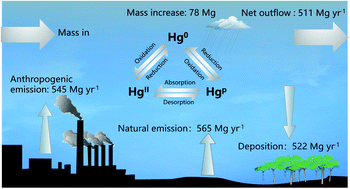Mercury pollution in China: implications on the implementation of the Minamata Convention†
Abstract
Mercury (Hg) is a toxic metal released into the environment through human activities and natural processes. Human activities have profoundly increased the amount of Hg in the atmosphere and altered its global cycling since the Industrial Revolution. Gaseous elemental Hg is the predominant form of Hg in the atmosphere, which can undergo long-range transport and atmospheric deposition into the aquatic systems. Hg deposition elevates the methylmercury (MeHg) level in fish through bioaccumulation and biomagnification, which poses a serious human health risk. Acute poisoning of MeHg can result in Minamata disease, while low-level long-term exposure in pregnant women can reduce the intelligence quotient of infants. After five sessions of intergovernmental negotiation, the Minamata Convention on mercury entered into force in August 2017 to protect human health and the environment from Hg pollution. Currently China contributes the largest quantity of Hg production, consumption, and emission globally. However, the status of Hg pollution in the environment in China and its associated health risk remains relatively unknown, which hinders the development of implementation plans of the Minamata Convention. In this paper, we provide a comprehensive review on the atmospheric release of Hg, distribution of air Hg concentration, human exposure to MeHg and health impacts caused by Hg pollution in China. Ongoing improvement of air pollution control measures is expected to further decrease anthropogenic Hg emissions in China. Air Hg concentrations in China are higher than the background values in the Northern Hemisphere, with spatial distribution largely influenced by anthropogenic emissions. Long-term observations of GEM in China show a decline in recent years. The net Hg transport outflow from China in 2013 is estimated to be 511 t year−1, and ∼60% of such outflow is caused by natural surface Hg emissions. Hg concentrations in fish and rice in China are relatively low and therefore the associated risks of human Hg exposure are low. Future research needs and recommendations for the implementation of the Minamata Convention are also discussed in this paper.

- This article is part of the themed collections: Geochemistry and Environmental Science: Processes & Impacts: Recent Review Articles


 Please wait while we load your content...
Please wait while we load your content...